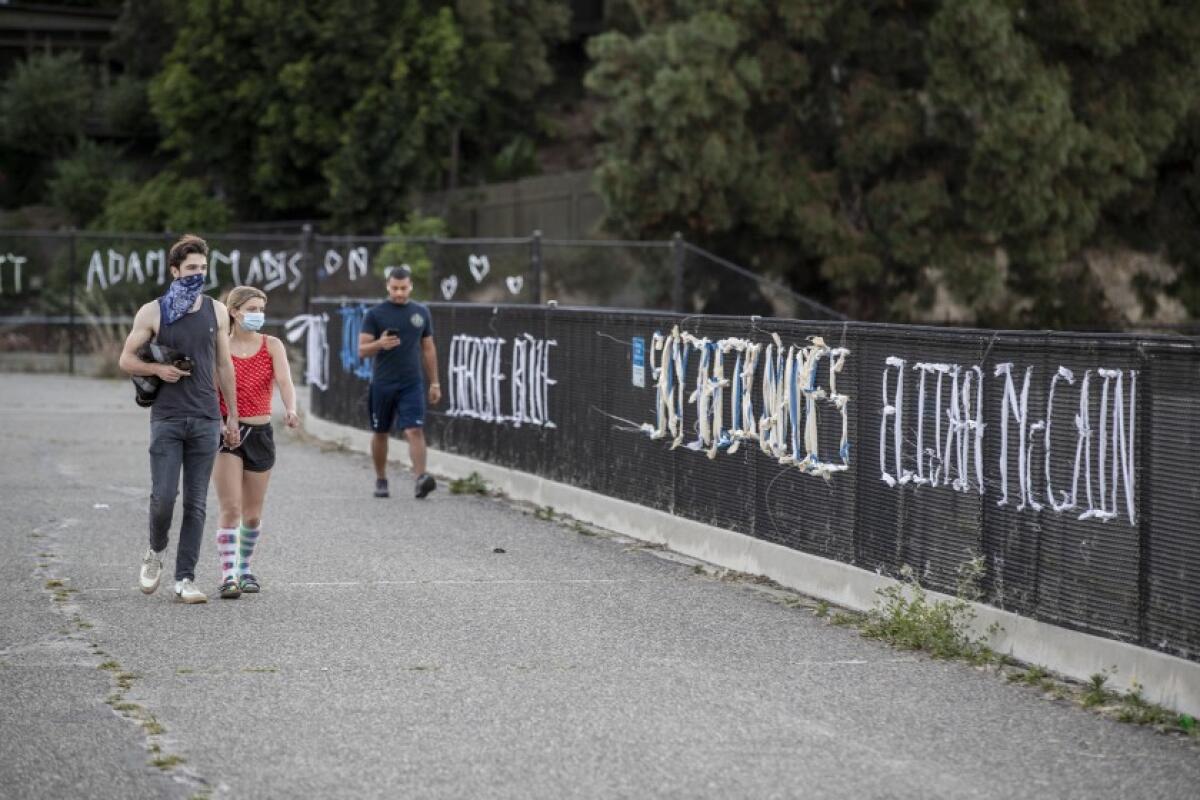Silver Lake memorial protesting police brutality is coming down

- Share via
The “Say Their Names: Silver Lake Memorial” — an installation running 2.2 miles on the chain link fence surrounding Silver Lake Reservoir and honoring more than 100 unarmed Black individuals killed by police in the U.S. — is coming down by Saturday, according to the artist organizers and the Los Angeles Department of Water and Power.
The fence is city property, and the DWP said organizers did not obtain permission to put it up, spokeswoman Dawn Cotterell said.
For the record:
2:35 p.m. Aug. 12, 2020An earlier version of this article erroneously said the DWP had set the deadline for removal of the memorial. Organizers of the memorial set the timeline.
“Say Their Names” co-organizer Lia Brody said that although she knew putting up the installation without permission was against DWP policy, “it was totally overridden by the importance of our mission.”
“This was an urgent moment in history when we really wanted to reach out to our community,” she added. “We’re not trying to sell anything. We were hoping they’d see this project in the context of today’s world.”
The artwork is composed of colorful, woven fabric such as cotton sheets and silky scarves. Community members began installing it on June 1 — the first name was George Floyd — and the memorial was mostly completed by June 5.
Project co-organizer Micah Woods said that not nearly enough time has passed for the installation to create much-needed awareness about police violence.
“It’s something people are forced to reckon with on their daily walks,” Woods said of the artwork. “I feel really sad, because it just deserves more time. There’s been so little done in terms of policy with the LAPD. And I feel there shouldn’t be an end to memorializing these people who have been so forgotten.”
The DWP has said no art installations are allowed on its properties. In an initial Times interview, DWP spokeswoman Cottrell was asked if “Say Their Names” had to come down. She said yes. Among the reasons Cottrell cited: “The fabric can be a hazard, it breaks down, there’s debris,” she said. “And not everyone wants something on the fence, or they may have different views and ideas of what art might be.”
After this article first published online Monday, the DWP responded to criticism on Twitter by saying, “Times story got it wrong.” It later replied to critical tweets by saying: “LADWP did not order or request the removal of the installation and have 100% supported this effort.”
Co-organizer Brody acknowledged that “Say Their Names” was never intended to be a permanent installation, and the timeline for its removal was set by her. But in a follow-up Times interview, she confirmed that she did feel pressure from the DWP, which conveyed community complaints about the artwork to her via an early supporter of the project, the volunteer-run nonprofit Silver Lake Reservoirs Conservancy.
“While there were not demands, there were concerns reported and encouragement for us to take this on,” Brody said of the deinstallation. She feared the artists were losing the goodwill of the DWP and the conservancy, and she did not want to cede control of the project. She wanted artists to take down the memorial “on their own terms, collectively and with consciousness. We wanted to take ownership of the process.”
Andrew Thomas, president of the Silver Lake Reservoirs Conservancy, said he got involved when a local resident emailed his group and the DWP to complain about the use of the reservoir fence “as a place for political signage.” Thomas said he emailed back with his support for Black Lives Matter signs, and “the conservancy took a position that was pro ‘Say Their Names’ to the DWP.”
Over time, Thomas said, community complaints to the DWP — he estimated the number as “between one and seven” — were relayed to Brody via the conservancy, “but at no point did they [DWP] express a desire or exert pressure to take down the memorial.”
On Tuesday The Times repeatedly asked the DWP to clarify its position and to confirm its previous statement that no installations of any kind would be allowed on DWP properties. The Times asked: “Is it the DWP’s position that the memorial must come down, eventually, yes or no?”
DWP community affairs manager Stephanie Spicer refused to answer the question in three email exchanges and instead responded with a statement that said the department had “100% supported this effort,” had discussed deinstallation with Brody and “have followed her lead on determining the appropriate timing.”
The installation of “Say Their Names” included about 150 people. Disassembling the artwork won’t be easy, Woods said. Many of the fabric knots are tight and triple-knotted; organizers have added laminated bios beside each name. The placards are affixed with zip ties that are cumbersome to undo, one by one. As part of the removal, Brody, Woods, co-organizer Eli Caplan and volunteers began taking down the bio placards last week, along with extraneous fabric and dead flowers.
Woods estimated that the rest of the process will take about two to three days. “It’s faster to take it down than putting it up, because there’s less weaving involved — but it’s still pretty labor intensive,” he said. “Our hope is to have 50 volunteers to help.”
Project organizers have been brainstorming with the Silver Lake Reservoirs Conservancy for a permanent memorial — a mural, perhaps, or a commemorative bench. They plan to approach the city with suggestions.
“What would be awesome would be to rename the meadow — the ‘Say Their Names Memorial Meadow,’” Brody said. “Or even a small plaque.”
Ideas are still in their infancy, Brody added. “We’d have to go to City Council meetings. But we wanted to put our energy towards a permanent marker of some kind. And for those who are upset about the names being removed, to start thinking about what’s next.”
Digital-art memorials to George Floyd, Breonna Taylor, Ahmaud Arbery and other black victims of white violence are rallying cries for social justice.
More to Read
Updates
2:35 p.m. Aug. 12, 2020: This article has been expanded to include additional interviews and to provide more context on the decision to take down the memorial.
The biggest entertainment stories
Get our big stories about Hollywood, film, television, music, arts, culture and more right in your inbox as soon as they publish.
You may occasionally receive promotional content from the Los Angeles Times.











